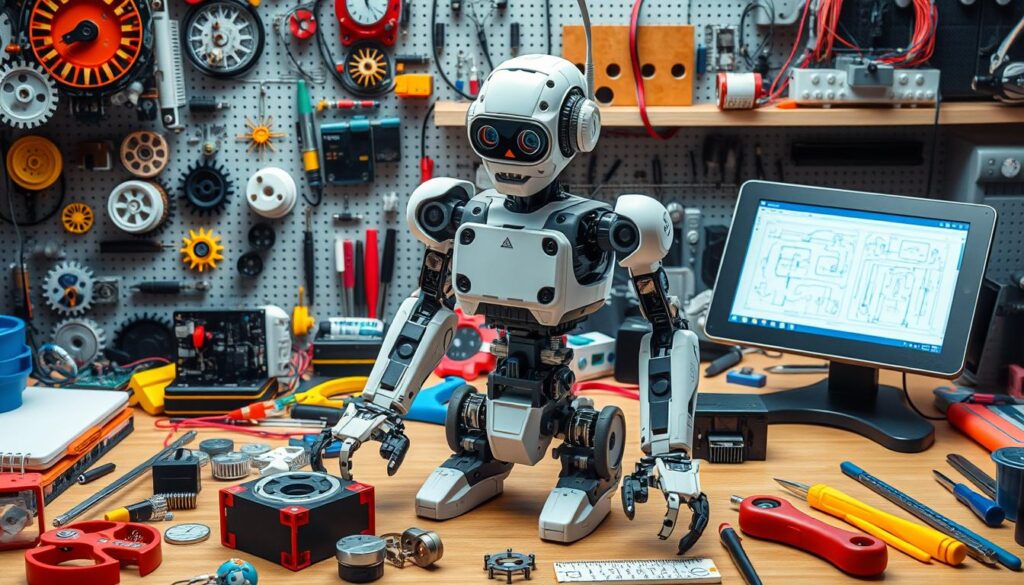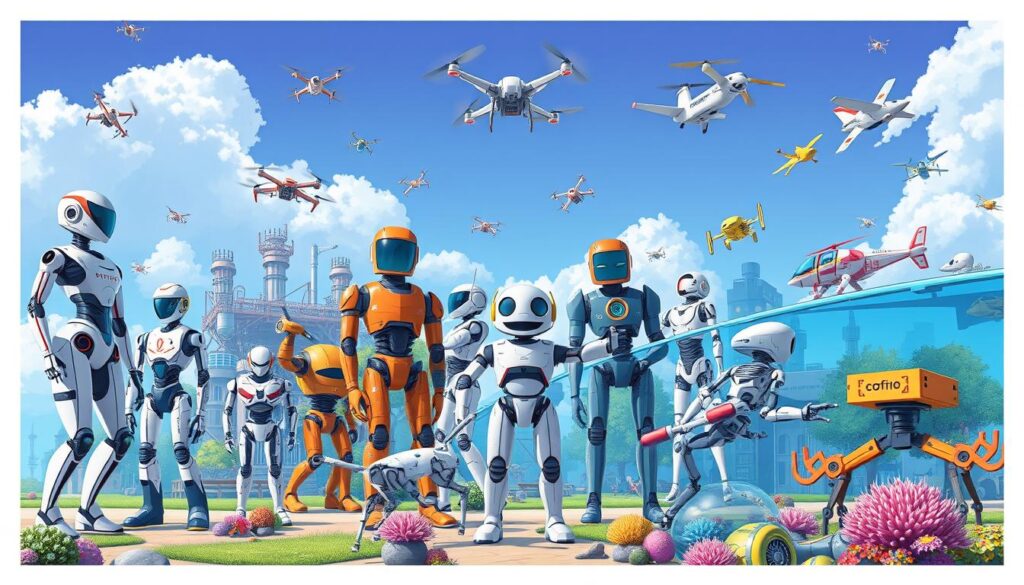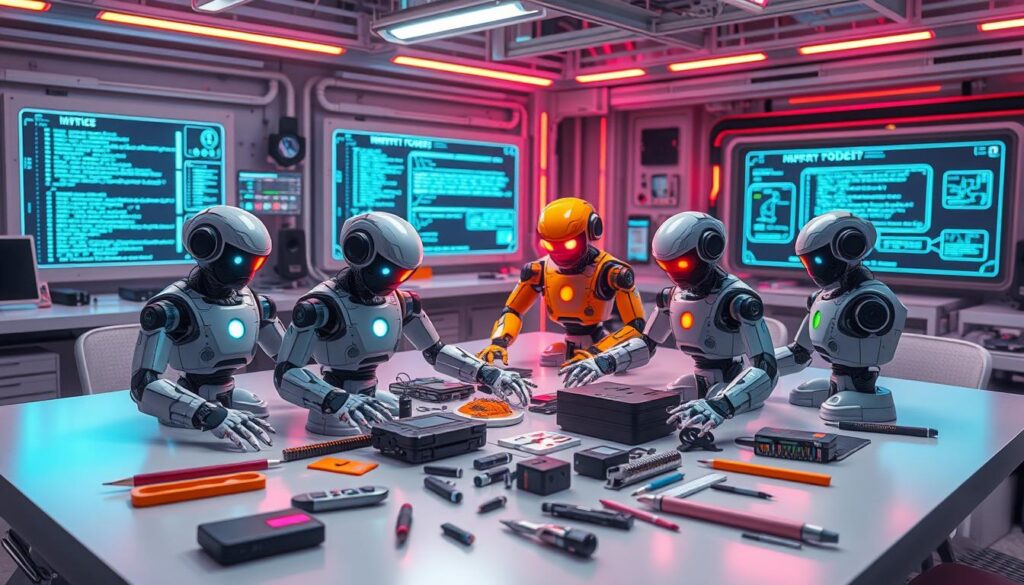Welcome to the world of robotics! If you’re curious about automation and want to dive into technology, you’re in the right spot. This guide will introduce you to robotics basics, helping you unlock its vast potential. It’s perfect for students, hobbyists, or anyone interested in technology.

Key Takeaways
- Discover the basics of robotics and how it is transforming industries and daily life
- Understand the diverse applications of robotics and its impact on the modern world
- Learn about the different types of robots and their unique capabilities
- Explore the fundamentals of robotics programming and coding for beginners
- Gain insights into the future of robotics and how you can be a part of this technological revolution
Unraveling the World of Robotics
Robotics is a field that combines engineering, computer science, and technology. It drives the automation revolution, changing how we live and work. We’ll explore what robotics is and how it’s part of our daily lives.
What is Robotics?
Robotics is about designing, building, and using robots. These machines can do many tasks, from simple to complex. They use sensors, actuators, and control systems to understand and act on their environment.
Robotics in Everyday Life
Robotics is not just for factories anymore. It’s in our homes and lives every day. From vacuum cleaners to smart assistants, robotics has made our lives easier.
- Robotic vacuum cleaners: These devices clean our homes without us.
- Smart assistants: Like Alexa and Siri, they help us with our schedules and smart home devices.
- Surgical robots: They help surgeons do complex operations with more precision and less risk.
- Self-driving cars: These cars use sensors and AI to change how we travel.
As robotics grows, we’ll see more of these technologies in our lives. They will make our lives more efficient and enjoyable.
“Robotics is the branch of technology that deals with the design, construction, operation, and application of robots and computer systems for their control, sensory feedback, and information processing.”
Robotics for Beginners
Starting your robotics journey is exciting and rewarding. You’ll learn the essential skills and knowledge needed to begin in robotics for beginners. You’ll understand the robot’s core components, basic programming, and design principles. This will prepare you for the world of robotics.
To start your robotics basics journey, let’s look at a robot’s main parts:
- Sensors: These are the “eyes and ears” of a robot, allowing it to perceive its environment and gather information.
- Actuators: The “muscles” of a robot, responsible for moving and manipulating objects.
- Control System: The “brain” of the robot, responsible for processing data, making decisions, and coordinating the robot’s actions.
As you get deeper into getting started with robotics, you’ll learn about basic programming and design. You’ll understand algorithms, programming languages, and mechanical and electrical engineering principles.
To build a strong foundation in essential robotics skills, check out online tutorials, robotic kits, and workshops. These resources will give you practical knowledge of robotics components and techniques.
“Robotics is not just a technical field; it’s a way of thinking, a way of solving problems.”
The journey of a robotics for beginners is exciting, full of possibilities. It can change how we interact with the world. Embrace the challenge and let your curiosity lead you in this captivating field.
Exploring the Different Types of Robots
In the world of robotics, there are many types of robots. Each one is made for specific tasks and challenges. From the big industrial robots on assembly lines to the helpful service robots in our homes, the world of robots is fascinating and always changing.
Industrial Robots
Industrial robots are the backbone of the manufacturing world. These types of robots are found in places like car factories and electronics plants. They do repetitive, precise tasks with great strength, speed, and accuracy. This has changed how we make things, making it more efficient and productive.
Service Robots
Industrial robots focus on making things, but service robots help us in everyday life. They assist in healthcare, like helping the elderly or doing surgeries, and do household tasks like vacuuming. These service robots make our lives easier and more comfortable. They are designed to be easy to use and fit into our daily lives.
| Type of Robot | Key Characteristics | Common Applications |
|---|---|---|
| Industrial Robots | High precision and speed Repetitive tasks Robust and heavy-duty | Automotive manufacturing Electronics assembly Welding and painting |
| Service Robots | User-friendly and adaptable Assist in everyday tasks Enhance human capabilities | Healthcare and rehabilitation Household chores (vacuuming, lawn mowing) Delivery and logistics |

“Robotics is the branch of technology that deals with the design, construction, operation, and application of robots.”
Exploring the world of robots shows how they are changing industries and improving our lives. From the precise work of industrial robots to the versatility of service robots, the future of robotics is exciting.
Getting Started with Robotics Programming
Robotics programming is key to making robots work. You’ll learn the basics of coding for robots here. This includes understanding programming languages and software used in robotics.
Introduction to Coding for Robots
Robotics programming requires skills in software development and hardware integration. You’ll need to know programming languages like C++, Python, and Java. These languages help create the systems that control how robots move and interact.
You’ll also look into robotics software and robot control systems. Tools like ROS (Robot Operating System) and MATLAB Robotics Toolbox make designing and deploying robots easier.
- Understand the common programming languages used in robotics, such as C++, Python, and Java.
- Explore the various robotics software and robot control systems available, like ROS and MATLAB Robotics Toolbox.
- Learn how to integrate hardware and software components to create fully functional robot systems.
- Develop the skills to design and implement complex robotics programming algorithms for tasks like navigation, manipulation, and sensor processing.
By learning the basics of coding for robots, you’ll unlock robotics and automation’s potential. Let’s start your journey to becoming a robotics programming expert!

Conclusion
By the end of this guide, you know a lot about robotics for beginners. You’ve learned the basics, different types of robots, and how to program them. Now, you’re ready to start your own robotics adventure.
Maybe you dream of being a robotics engineer or just want to play with robots. The opportunities in this field are endless. The future of robotics looks bright, with new tech leading to more innovation and solving problems.
Keep exploring and trying new things in robotics. The robotics career path is full of exciting and meaningful jobs. Robotics can change industries and help people in many ways, making a big difference in our world.
FAQ
What is robotics?
Robotics is a field that mixes engineering, computer science, and technology. It creates machines that can do tasks humans used to do. These machines are called robots.
How are robots used in everyday life?
Robots are everywhere in our lives. They help in making things in factories and assist us at home. They also help in healthcare and in teaching and fun activities.
What are the essential skills needed to get started in robotics?
To start in robotics, you need to know the basics. You should learn about robot parts, programming, and design. Also, a good background in engineering, computer science, and math is important.
What are the different types of robots?
Robots are mainly two types: industrial and service robots. Industrial robots work in factories and assembly lines. Service robots help people in healthcare and at home.
How do I start programming robots?
To program robots, you need to learn coding languages used in robotics. You also need to understand control systems and hardware interfaces. This will help you make your robots work.
What are the future opportunities in the field of robotics?
Robotics has a bright future. New careers will open up in robotics engineering and research. Robots will also be used in more industries and jobs.